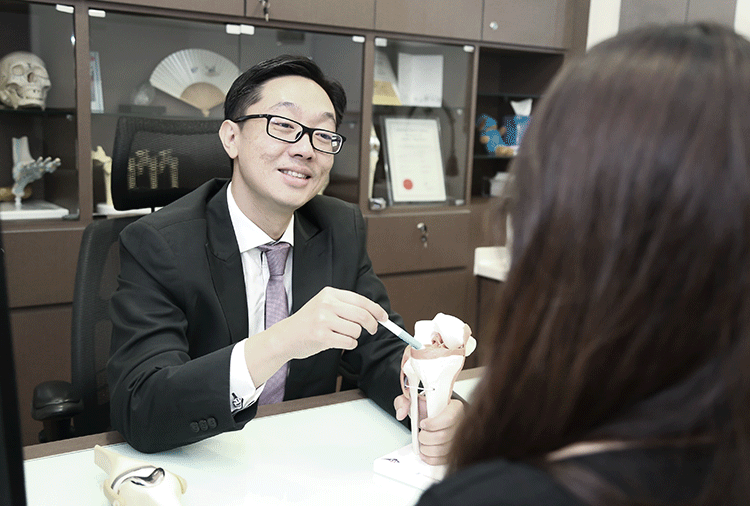Arthritis is a common condition characterised by inflammation and stiffness in the joints, leading to pain, swelling, and decreased mobility. It encompasses a variety of conditions affecting the joints and surrounding tissues, with osteoarthritis and rheumatoid arthritis being the most prevalent types. Treatment is crucial to alleviate symptoms, slow disease progression, preserve joint function, and improve overall quality of life.
What Is Arthritis, And Why Is Treatment Important?
What Are The Causes And Risk Factors Of Arthritis?
Several factors can contribute to the development of arthritis, including:
Age – Osteoarthritis, the most common type of arthritis, typically occurs with aging as wear and tear on the joints lead to cartilage breakdown and inflammation.
Genetics – A family history of arthritis may increase the risk of developing the condition, suggesting a genetic predisposition.
Joint Injury – Previous joint injuries or trauma can increase the likelihood of developing osteoarthritis later in life.
Obesity – Excess weight stresses joints, particularly weight-bearing joints such as the knees, hips, and spine, increasing the risk of arthritis.
Autoimmune Disorders – Rheumatoid arthritis and other autoimmune diseases occur when the immune system mistakenly attacks the body’s tissues, including the joints, leading to inflammation and joint damage.
Infection – Certain infections can trigger inflammatory arthritis, such as septic arthritis, Lyme disease, or viral infections.
Occupational Hazards – Jobs involving repetitive movements, heavy lifting, or prolonged periods of standing may increase the risk of developing arthritis.
What Are The Common Symptoms Of Arthritis?
The symptoms of arthritis can vary depending on the type and severity of the condition, but common symptoms may include:
Joint Pain – Persistent pain or discomfort in one or more joints, typically worsened by movement or weight-bearing activities.
Joint Stiffness – Stiffness or reduced range of motion in the affected joints, particularly after periods of inactivity or waking in the morning.
Joint Swelling – Swelling, warmth, or redness around the affected joints, indicating inflammation and fluid accumulation.
Joint Deformities – In advanced cases, arthritis can lead to joint deformities, such as knobby finger joints or misaligned knees.
Fatigue – Generalized fatigue or malaise, particularly with inflammatory arthritis like rheumatoid arthritis.
Joint Instability – Weakness or instability in the affected joints, making it difficult to perform daily activities or maintain balance.
Decreased Mobility – Difficulty walking, climbing stairs, or performing tasks that require fine motor skills due to joint pain and stiffness.
How Is Arthritis Diagnosed?
Clinical Examination
Medical History – The doctor will review your medical history, including symptoms, previous injuries, family history of arthritis, and any underlying medical conditions.
Physical Examination – A thorough examination of the affected joints will be conducted. This may involve assessing joint tenderness, swelling, warmth, range of motion, and deformities.
Functional Assessment – The doctor may evaluate your ability to perform daily activities and tasks, such as walking, climbing stairs, or gripping objects.
Gait Analysis – Observation of your walking pattern (gait) to assess for any abnormalities or compensatory movements related to joint pain or stiffness.
Palpation – Gentle pressure is applied to the joints to identify tenderness, swelling, or inflammation areas.
Special Tests – Specific manoeuvres or tests may be performed to evaluate joint stability, ligament integrity, or muscle strength.
Diagnostic Tests
- Blood Tests
- Joint Aspiration (Arthrocentesis)
- X-rays
- MRI (Magnetic Resonance Imaging)
- CT (Computed Tomography) Scan
- Ultrasound
- Bone Scan
- Joint Function Tests
What Are The Arthritis Treatment Options?
Medications
- Pain Relievers – Over-the-counter or prescription nonsteroidal anti-inflammatory drugs (NSAIDs) such as ibuprofen, naproxen, or aspirin may help reduce pain and inflammation associated with arthritis.
- Analgesics – Acetaminophen (Tylenol) may be used to alleviate pain associated with arthritis, particularly in individuals who cannot tolerate NSAIDs.
- Disease-Modifying Antirheumatic Drugs (DMARDs) – DMARDs such as methotrexate, hydroxychloroquine, or sulfasalazine may be prescribed to slow the progression of inflammatory arthritis such as rheumatoid arthritis or psoriatic arthritis.
- Biologic Response Modifiers – Biologic medications, such as tumour necrosis factor (TNF) inhibitors or interleukin-6 (IL-6) inhibitors, may be prescribed to reduce inflammation and slow joint damage in individuals with certain types of arthritis.
- Corticosteroids – Injections of corticosteroids into affected joints may be recommended to reduce inflammation and alleviate pain in cases of severe or refractory arthritis.
Physical Therapy
Occupational Therapy
Lifestyle Modifications
- Weight Management – Maintaining a healthy weight or losing excess weight can help reduce stress on weight-bearing joints such as the knees, hips, and spine, thereby decreasing pain and improving joint function.
- Exercise – Regular low-impact exercise, such as walking, swimming, or cycling, can help improve joint flexibility, strengthen muscles around the affected joints, and reduce pain. A physical therapist can design a personalised exercise program tailored to the individual’s needs and limitations.
- Joint Protection – Avoiding activities that exacerbate joint pain or strain, using assistive devices (such as canes or braces) to reduce joint stress, and practising proper body mechanics can help protect and preserve joint function.
Surgical Intervention
In cases of severe or refractory arthritis that do not respond to conservative treatments, surgical intervention may be considered. Surgical options for arthritis may include:
- Joint Replacement Surgery – Total joint replacement surgery may be recommended to replace severely damaged joints with artificial implants, such as in cases of severe osteoarthritis or rheumatoid arthritis affecting the knees, hips, or shoulders.
- Joint Fusion Surgery – Joint fusion surgery may be considered to stabilise and immobilise severely damaged joints, particularly in cases of inflammatory arthritis or severe joint deformity.
Recovery And Prevention Strategies For Arthritis
For Recovery:
- Over-the-counter or prescription medications, such as nonsteroidal anti-inflammatory drugs (NSAIDs), corticosteroids, disease-modifying antirheumatic drugs (DMARDs), or biologics, can help alleviate pain, reduce inflammation, and manage symptoms associated with arthritis. Consult with a healthcare professional to determine the most appropriate medication regimen based on the type and severity of arthritis.
- A physical therapist can design a customised exercise program to strengthen the muscles surrounding the affected joints, improve flexibility, and enhance joint stability. Physical therapy may also include heat, cold, ultrasound, or electrical stimulation to alleviate pain and improve function.
- An occupational therapist can provide strategies and adaptations to help individuals with arthritis perform daily activities more easily and with less pain. This may include recommendations for assistive devices, ergonomic modifications, and energy conservation techniques.
- Avoid activities that exacerbate joint pain or cause undue stress on the affected joints. Use assistive devices such as braces, splints, or canes to support and reduce joint strain during daily activities.
- Maintaining a healthy weight or losing excess weight can help reduce stress on weight-bearing joints, such as the knees and hips, and alleviate arthritis symptoms. Even modest weight loss can have significant benefits for joint health.
- In severe arthritis cases that do not respond to conservative treatments, surgical interventions such as joint replacement surgery or arthroscopic surgery may be considered to alleviate pain and restore joint function.
For Prevention:
- Engage in regular, low-impact exercises such as walking, swimming, cycling, or tai chi to improve joint flexibility, strengthen muscles, and reduce the risk of arthritis. As health guidelines recommend, aim for at least 150 minutes of moderate-intensity exercise per week.
- Incorporate strength training exercises into your fitness routine to strengthen the muscles surrounding the joints, providing better support and stability. Focus on exercises targeting major muscle groups, including the quadriceps, hamstrings, glutes, and core muscles.
- Perform regular stretching and range of motion exercises to maintain joint flexibility and prevent stiffness. Include exercises that target the muscles and tendons surrounding the joints, such as yoga or Pilates.
- Follow a balanced diet rich in fruits, vegetables, whole grains, lean protein, and healthy fats to maintain overall joint health. Certain nutrients, such as omega-3 fatty acids, vitamin D, and antioxidants, may be anti-inflammatory and benefit individuals with arthritis.
- Choose activities and sports that are less likely to exacerbate joint pain or cause injury, such as swimming, cycling, or water aerobics. Avoid high-impact activities or sports involving repetitive joint stress, such as running or tennis.
- Avoid repetitive movements or activities that place excessive stress on the joints, particularly if you have a history of joint pain or arthritis. Take breaks and alternate tasks to prevent overuse injuries and give your joints time to rest and recover.
- Stay proactive about your joint health by scheduling regular check-ups with your doctor. Early detection and intervention can help identify risk factors for arthritis and implement appropriate preventive measures.






